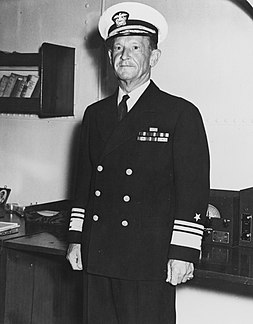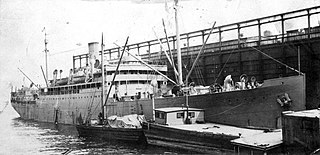
The United States Fleet Forces Command (USFF) is a service component command of the United States Navy that provides naval forces to a wide variety of U.S. forces. The naval resources may be allocated to Combatant Commanders such as United States Northern Command (USNORTHCOM) under the authority of the Secretary of Defense. Originally formed as United States Atlantic Fleet (USLANTFLT) in 1906, it has been an integral part of the defense of the United States of America since the early 20th century. In 2002, the Fleet comprised over 118,000 Navy and Marine Corps personnel serving on 186 ships and in 1,300 aircraft, with an area of responsibility ranging over most of the Atlantic Ocean from the North Pole to the South Pole, the Caribbean Sea, Gulf of Mexico, and the waters of the Pacific Ocean along the coasts of Central and South America.

The seventh USS Washington (ACR-11/CA-11/IX-39), also referred to as "Armored Cruiser No. 11", and later renamed Seattle and reclassified CA-11 and IX-39, was a United States Navy Tennessee-class armored cruiser. She was laid down on 23 September 1903 at Camden, New Jersey, by the New York Shipbuilding Corporation, launched on 18 March 1905, sponsored by Miss Helen Stewart Wilson, daughter of United States Senator John L. Wilson of Washington state, and commissioned at the Philadelphia Navy Yard on 7 August 1906, Captain James D. Adams in command.

On September 3, 1939, the British and French declarations of war on Germany initiated the Battle of the Atlantic. The United States Navy Chief of Naval Operations (CNO) established a combined air and ship patrol of the United States Atlantic coast, including the Caribbean, on September 4. President Franklin D. Roosevelt declared the United States' neutrality on September 5, and declared the naval patrol a Neutrality Patrol. Roosevelt's initiation of the Neutrality Patrol, which in fact also escorted British ships, as well as orders to U.S. Navy destroyers first to actively report U-boats, then "shoot on sight", meant American neutrality was honored more in the breach than observance.

The Home Fleet was a fleet of the Royal Navy that operated from the United Kingdom's territorial waters from 1902 with intervals until 1967.

Frank Jack Fletcher was an admiral in the United States Navy during World War II. Fletcher was the operational commander at the pivotal Battles of Coral Sea and of Midway. As a lieutenant, Fletcher was awarded the Medal of Honor for his actions in the battle at Veracruz. He was the nephew of Admiral Frank Friday Fletcher, who was also awarded the Medal of Honor for actions at Veracruz.
A destroyer squadron is a naval squadron or flotilla usually consisting of destroyers rather than other types of vessel. In some navies other vessels, such as frigates, may be included. In English the word "squadron" tends to be used for larger and "flotilla" for smaller vessels; both may be used for destroyer units. Similar formations are used in non-English-speaking countries, e.g., the "escadrille"—which would translate directly as "squadron"—in France.

USS Upshur (DD–144) was a Wickes-class destroyer in the United States Navy before and during World War II. She was the first ship named for Rear Admiral John Henry Upshur.

Vice Admiral Morton Lyndholm Deyo was an officer in the United States Navy, who was a naval gunfire support task force commander of World War II.

Commander, Naval Surface Force, Atlantic (COMNAVSURFLANT) is a post within the United States Fleet Forces Command. As Naval Surface Force Atlantic, it is a military formation, but the organization is often known as SURFLANT. Its headquarters are at the Naval Station Norfolk, Norfolk, Virginia. The current commander is Rear Admiral Brendan R. McLane. COMNAVSURFLANT supervises all surface ships based on the Eastern United States and Gulf Coast of the United States, as well as ships forwarded deployed to Naval Station Rota, Spain.

USS Lenape (ID-2700) was a troop transport for the United States Navy in 1918, during World War I. She was launched in 1912 as SS Lenape, a passenger steamer for the Clyde Line. After the entry of the United States into World War I in 1917, she was chartered by the United States Army as transport USAT Lenape. After her Navy service ended in October 1918, she was returned to the Army.
SS Duca d'Aosta was an Italian ocean liner for Navigazione Generale Italiana named after one of the Dukes of Aosta. Launched in 1908, she sailed between Italy and New York and South America for most of her career. During World War I she was employed as a troopship carrying United States troops to France as part of the United States Navy Cruiser and Transport Force. She was scrapped in 1929.
SS Caserta was an Italian ocean liner named for the city of Caserta in the Campania region of Italy. She was previously known as SS Maritzburg and SS Mendoza, and was later renamed SS Venezuela. Launched in 1904 as Maritzburg for the Bucknall Line, the ship was sold to Lloyd Italiano in 1905 and renamed Mendoza. Renamed Caserta in 1914, she was placed under the Navigazione Generale Italiana banner in 1918. During World War I she was employed as a troopship carrying United States troops to France as part of the United States Navy Cruiser and Transport Force. In 1923, she was renamed Venezuela and transferred to La Veloce for South American service, but reverted to NGI control in 1924. She was scrapped in 1928.
SS Re d'Italia was an Italian ocean liner for Lloyd Sabaudo named for the King of Italy. Launched in 1906, she sailed between Italy and New York and South America for most of her career. During World War I she was employed as a troopship carrying United States troops to France as part of the United States Navy Cruiser and Transport Force. She was scrapped in 1929.

USS Henry R. Mallory (ID-1280) was a transport for the United States Navy during World War I. She was also sometimes referred to as USS H. R. Mallory or as USS Mallory. Before her Navy service she was USAT Henry R. Mallory as a United States Army transport ship. From her 1916 launch, and after her World War I military service, she was known as SS Henry R. Mallory for the Mallory Lines. Pressed into service as a troopship in World War II by the War Shipping Administration, she was torpedoed by the German submarine U-402 in the North Atlantic Ocean and sank with the loss of 272 men—over half of those on board.

SS El Occidente was a cargo ship for the Morgan Line, a subsidiary of the Southern Pacific Company. During World War I, she was known as USAT El Occidente in service with the United States Army and as USS El Occidente (ID-3307) in service with the United States Navy. At the end of war, she reverted to her original name of SS El Occidente.

Richard Lansing Conolly was a United States Navy admiral, who served during World War I and World War II.

United States Navy operations during World War I began on April 6, 1917, after the formal declaration of war on the German Empire. The American navy focused on countering enemy U-boats in the Atlantic Ocean and the Mediterranean Sea, while convoying men and supplies to France and Italy. Because of United States' late entry into the war, her capital ships never engaged the German fleet, and few decisive submarine actions occurred.

Francis John Higginson was an officer in the United States Navy during the American Civil War and Spanish–American War. He rose to the rank of rear admiral and was the last commander-in-chief of the North Atlantic Squadron and first commander-in-chief of the North Atlantic Fleet.

Thomas Ross Cooley was a decorated officer in the United States Navy with the rank of Vice Admiral. A veteran of two world wars, he distinguished himself as commanding officer of battleship USS Washington during Mariana Islands campaign and later as Commander, Battleship Division Six during the battles of Iwo Jima and Okinawa.














